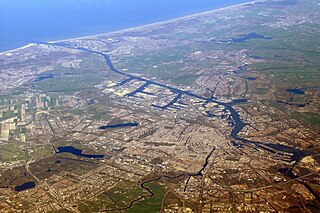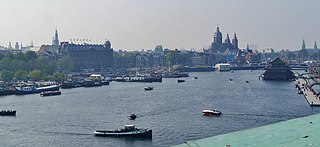
IJmuiden is a port city in the Dutch province of North Holland. It is the main town in the municipality of Velsen which lies mainly to the south-east. Including its large sea locks, it straddles the mouth of the North Sea Canal to Amsterdam. To the south it abuts a large reserve of plant-covered dunes, the Zuid-Kennemerland National Park. The city is on the south bank; the north bank is otherwise a steel plant and Velsen-Noord.

IJburg is a residential neighbourhood under construction in Amsterdam, Netherlands. It is situated in the IJmeer and is being built on artificial islands which have been raised from the lake. The Haveneiland, Rieteilanden, Steigereiland and Centrumeiland are already inhabited as of 2004. It is part of the municipality Amsterdam-Oost and also contains the Diemerpark, one of the city's largest parks.

West 8 is an urban planning and landscape architecture firm founded by Adriaan Geuze and Paul van Beek in Rotterdam, Netherlands in 1987. It is known for its contemporary designs and innovative solutions to urban planning problems using lighting, metal structures, and color. Van Beek is no longer part of the firm.

Jacques l'Hermite, sometimes also known as Jacques le Clerq, was a Flemish merchant, explorer, and admiral known for his journey around the globe with the Nassau Fleet (1623–1626) and for his blockade and raid on Callao in 1624 during that same voyage in which he also died. He served the Dutch East India Company as chief merchant in Bantam and Ambon Island in the Dutch East Indies. The Chilean Hermite Islands near Cape Horn which his fleet charted in February 1624 are named after him.

The port of Amsterdam is an inland seaport in Amsterdam in North Holland, Netherlands. It is the 14th busiest port in Europe by total cargo tonnage. In 2023, the port of Amsterdam had a cargo throughput of 63 million tons.

Frits van Dongen is an architect from the Netherlands. He designed a canal-side municipal theatre for the city of Leeuwarden with his firm De Architecten Cie. The building he designed that is known as The Whale is in an area known as the Oostelijke Handelskade that includes "some of The Netherlands' most cutting-edge housing developments including Piraeus, designed by Hans Kollhoff and Christian Rappit, "Hoop, Liefde en Fortuin" by Rudy Uytenhaak" and one of Jamie Oliver's "Fifteen" restaurants. Rotterdam Maaskant Prize for Young Architects 2005 winner Oliver Thill and his architecture partner André Kempe, both from East Germany, both worked in van Dongen's office.

The KNSM Island is a man-made island in the Eastern Docklands of Amsterdam. KNSM stands for the Koninklijke Nederlandsche Stoomboot-Maatschappij, the Royal Dutch Steamboat Shipping company which used to have its headquarters and its docks on the island. It is now a large residential area containing modern architecture with a mostly well-off population.

The Zeeheldenbuurt is a neighbourhood of Amsterdam, Netherlands. Located in the borough Amsterdam-West, it borders directly on the Westelijke Eilanden to the west. It lies between the Westerkanaal and the Westerdok; to the north is Houthaven and the IJ. The neighbourhood is served by the S100 road, and is sometimes confused with the nearby Admiralenbuurt.

Wilhelmina Jacoba Moussault-Ruys, was a Dutch landscape and garden architect. Her gardening legacy is maintained in the Dutch town of Dedemsvaart, which is home to the Tuinen Mien Ruys. With people such as Piet Oudolf, she is considered a leader in the "New Perennial Movement."

Amsterdam-Oost is a borough of Amsterdam, Netherlands, established in May 2010 after a merger of the former boroughs of Zeeburg and Oost-Watergraafsmeer. In 2013, the borough had almost 123,000 inhabitants.
Java-eiland is a neighbourhood of Amsterdam, Netherlands. It is located on a peninsula, surrounded on three sides by water and on the east by the KNSM Island neighbourhood.

Oostelijke Eilanden, also known as Oostelijke Eilanden en Kadijken, is a neighbourhood in the centre of Amsterdam, Netherlands, consisting of Kattenburg, Wittenburg and Oostenburg.

Westelijke Eilanden are three islands in the Centrum district of Amsterdam: Bickerseiland, Prinseneiland and Realeneiland. They are located to the south of the IJ and the Zeeheldenbuurt, to the north of the railway line between Central Station and Amsterdam-Sloterdijk, to the west of the Westerdok and to the east of the Planciusbuurt on the Westerkanaal. The Westelijke Eilanden form the core of the Golden Reael area, which also includes the adjacent Westerdok island, the Haarlemmerbuurt and the Planciusbuurt.

The Nieuwe Vaart or Nieuwevaart is a 17th-century canal in Amsterdam that runs from the center to Amsterdam-Oost.

Prins Hendrikkade is a major street in the centre of Amsterdam. It passes Amsterdam Central Station, intersects the Damrak at the mouth of the Amstel river, and forms the southern end of the IJtunnel across the IJ bay. The street formed the northern edge and outer harbour of the city until the 19th century. It was named after Prince Henry of the Netherlands, youngest son of King William II, following Henry's death in 1879.

Amsterdam tram line 26, popularly known as the IJtram, is a tram line operating between Amsterdam Centraal station and the IJburg district in Amsterdam, the Netherlands. As of 2019, the IJtram was the busiest tram line in Amsterdam, carrying 30,000 riders per day. The 8.5-kilometre (5.3 mi) line has 11 stops and a scheduled end-to-end travel time of 22 minutes. It is of existential importance to the IJburg district, as it is the only public transport connection to the city centre for a suburb that is growing to a population of 45,000. When it is interrupted a free replacement bus 76 operates.

The Oosterdok is a former wet dock in Amsterdam. It was created in 1831–1832 by constructing the Oosterdoksdam and the Oosterdoksluis, forming a reliable deep port closed off from the tidal IJ.
The Amsterdam Ferries, run by GVB, consist of several lines over the IJ and the Amsterdam–Rhine Canal in the Netherlands. The lines are numbered F1 through F9. All of the services are free for pedestrians, bicycles, mopeds, scooters and wheelchair-accessible vehicles.
The following is an alphabetical list of articles related to Amsterdam. Amsterdam is the capital city of the Netherlands.





















